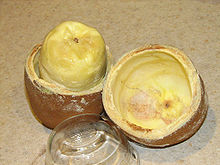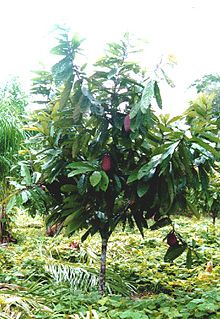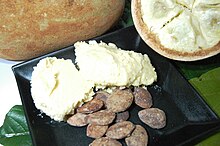Theobroma grandiflorum
| Cupuaçu | |
|---|---|

| |
Conservation status
| |
| Scientific classification | |
| Kingdom: | Plantae |
| Clade: | Tracheophytes |
| Clade: | Angiosperms |
| Clade: | Eudicots |
| Clade: | Rosids |
| Order: | Malvales |
| Family: | Malvaceae |
| Genus: | Theobroma |
| Species: | T. grandiflorum
|
| Binomial name | |
| Theobroma grandiflorum (Willd. ex Spreng.) K.Schum.
| |
Theobroma grandiflorum, commonly known as cupuaçu, also spelled cupuassu, cupuazú, cupu assu, or copoasu, is a tropical rainforest tree related to cacao.[2] Native and common throughout the Amazon basin, it is naturally cultivated in the jungles of Colombia, Bolivia and Peru and in the north of Brazil, with the largest production in Pará, Amazonas and Amapá.[2] The pulp of the cupuaçu fruit is consumed throughout Central and South America, especially in the northern states of Brazil,[3] and is used to make ice creams, snack bars,[4] and other products.[5][6]
Description[]

Cupuaçu trees usually range from 5–15 m (16–49 ft) in height, though some can reach 20 m (66 ft). They have brown bark, and the leaves range from 25–35 cm (9.8–13.8 in) long and 6–10 cm (2.4–3.9 in) across, with 9 or 10 pairs of veins. As they mature, the leaves change from pink-tinted to green, and eventually they begin bearing fruit.[7]
Flowers of cupuaçu are structurally complex, and require pollination from biotic vectors.[8] The majority of cupuaçu trees are self-incompatible, which can result in decreased pollination levels, and consequently, a decrease in fruit yields.[8] Pollination can also be negatively affected by environmental conditions. Pollinators, which include chrysomelid weevils and stingless bees, are unable to fly between flowers in heavy rains.[8]

The white pulp of the cupuaçu has an odour described as a mix of chocolate and pineapple and is frequently used in desserts, juices and sweets.[2] The juice tastes primarily like pear, banana, passion fruit, and melon.[9][10]
Cultivation[]

Cupuaçu is most commonly propagated from seed, but grafting and rooted cuttings are also used.[11]
Cupuaçu trees are often incorporated in agroforestry systems throughout the Amazon due to their high tolerance of infertile soils, which are predominate in the Amazon region.[11]
Cupuaçu is generally harvested from the ground once they have naturally fallen from the tree. It can be difficult to determine peak ripeness because there is no noticeable external color change in the fruit. However studies have shown that in Western Colombian Amazon conditions, fruits generally reach full maturity within 117 days after fruit set.[12] Brazilians either eat it raw or use it in making sweets.[13]
Commercial food products include pulp and powder.[14]
Pests and diseases[]
Witches’ broom (Moniliophthora perniciosa) is the most prominent disease that affects cupuaçu trees.[15] It affects the entire tree and can result in significant loss of yields, as well as tree death if left untreated. Regular pruning is recommended to reduce the severity of this disease in cupuaçu plantings.[15]
Cupuaçu supports the butterfly herbivore, "lagarta verde", Macrosoma tipulata (Hedylidae), which can be a defoliator.[16]
Phytochemicals[]
Cupuaçu flavors derive from its phytochemicals, such as tannins, glycosides, theograndins, catechins, quercetin, kaempferol and isoscutellarein.[17] It also contains theacrine, caffeine, theobromine, and theophylline as found in cacao, although with a much lower amount of caffeine.[18][19][20]
Cupuaçu butter[]

Cupuaçu butter is a triglyceride composed of saturated and unsaturated fatty acids, giving the butter a low melting point (approximately 30 °C) and texture of a soft solid, lending its use as a confectionery resembling white chocolate.[2] Main fatty acid components of cupuaçu butter are stearic acid (38%), oleic acid (38%), palmitic acid (11%) and arachidic acid (7%).[21][19]
See also[]
References[]
- ^ Fernandez, E.; Moraes, M.; Martinelli, G.; Colli-Silva, M. (2021). "Theobroma grandiflorum". IUCN Red List of Threatened Species. 2021: e.T191158664A191158666. doi:10.2305/IUCN.UK.2021-1.RLTS.T191158664A191158666.pt. Retrieved 19 November 2021.{{cite iucn}}: error: malformed |doi= identifier (help)
- ^ a b c d Giacometti, DC (1994). "Cupuaçu". In Bermejo, J.E. Hernándo; León, J. (eds.). Neglected Crops: 1492 from a Different Perspective. Plant Production and Protection Series No. 26. Rome, Italy: FAO. pp. 205–209. ISBN 978-92-5-103217-6.
- ^ "Cupuaçu - the taste of the Amazon - Kew". kew.org. Retrieved 28 October 2018.
- ^ Balston, Catherine; Derry, Johanna (17 April 2014). "Cupuaçu: Brazil's new alternative to chocolate". The Guardian. Retrieved 28 October 2018.
- ^ Prazeres, Isadora Cordeiro dos; Domingues, Alessandra Ferraiolo Nogueira; Campos, Ana Paula Rocha; Carvalho, Ana Vânia (June 2017). "Elaboration and characterization of snack bars made with ingredients from the Amazon". Acta Amazonica. 47 (2): 103–110. doi:10.1590/1809-4392201602203.
- ^ "Brazil: Biodiversity for Food and Nutrition". b4fn.org. Retrieved 28 October 2018.
- ^ "Theobroma grandiflorum Cupuassu, Cupuacu PFAF Plant Database". pfaf.org. Retrieved 28 October 2018.
- ^ a b c Venturieri, Giorgini Augusto (March 2011). "Flowering levels, harvest season and yields of cupuassu (Theobroma grandiflorum)". Acta Amazonica. 41 (1): 143–152. doi:10.1590/S0044-59672011000100017.
- ^ Silva, F.M.; Silva, C.L.M. (February 2000). "Note. Quality evaluation of cupuaçu (Theobroma grandiflorum) purée after pasteurization and during storage / Nota. Calidad del puré de cupuaçu (Theobroma grandiflorum) después de la pasterización y durante su almacenamiento". Food Science and Technology International. 6 (1): 53–58. doi:10.1177/108201320000600108. S2CID 98661637.
- ^ Teixeira, Maria Francisca Simas; Andrade, Jerusa Souza; Fernandes, Ormezinda Celeste Cristo; Durán, Nelson; Lima Filho, José Luiz de (2011). "Quality Attributes of Cupuaçu Juice in Response to Treatment with Crude Enzyme Extract Produced by Aspergillus japonicus 586". Enzyme Research. 2011: 494813. doi:10.4061/2011/494813. PMC 3206358. PMID 22114735.
- ^ a b Schroth, G. (2000). "Growth, Yield and Mineral Nutrition of Cupuacu (Theobroma grandiflorum) in Two Multi-Strata Agroforestry Systems on a Ferralitic Amazonian Upland Soil at Four Fertilization Levels". Journal of Applied Botany.
- ^ Hernández L, Claudia; Hernández G, María Soledad (January 2012). "Growth and development of the cupuaçu fruit (Theobroma grandiflorum [Willd. Ex Spreng.] Schum.) in the western colombian Amazon". Agronomía Colombiana. 30 (1): 95–102. ProQuest 1677579349.
- ^ "This Brazilian Fruit Makes Beer, Ice Cream, and Faux Chocolate". Atlas Obscura. Retrieved 28 October 2018.
- ^ Silva, Alessandra Eluan da; Silva, Luiza Helena Meller da; Pena, Rosinelson da Silva (December 2008). "Comportamento higroscópico do açaí e cupuaçu em pó" [Hygroscopic behavior of açaí and cupuaçu powders]. Ciência e Tecnologia de Alimentos (in Portuguese). 28 (4): 895–901. doi:10.1590/S0101-20612008000400020.
- ^ a b Alves, Rafael Moysés; Resende, Marcos Deon Vilela de; Bandeira, Bruna dos Santos; Pinheiro, Thiago Martins; Farias, Daniella Cristina Raiol (December 2009). "Evolução da vassoura-de-bruxa e avaliação da resistência em progênies de cupuaçuzeiro". Revista Brasileira de Fruticultura. 31 (4): 1022–1032. doi:10.1590/S0100-29452009000400015.
- ^ Lourido, Gilcélia; Silva, Neliton M.; Motta, Catarina (February 2007). "Parâmetros biológicos e injúrias de Macrosoma tipulata Hübner (Lepidoptera: Hedylidae), em cupuaçuzeiro [Theobroma grandiflorum (Wild ex Spreng Schum)] no Amazonas" [Biological parameters and damage by Macrosoma tipulata Hübner (Lepidoptera: Hedylidae), in cupuaçu tree [Theobroma grandiflorum (Wild ex Spreng Schum)] in Amazonas, Brazil]. Neotropical Entomology (in Portuguese). 36 (1): 102–106. doi:10.1590/s1519-566x2007000100012. PMID 17420867.
- ^ Yang, Hui; Protiva, Petr; Cui, Baoliang; Ma, Cuiying; Baggett, Scott; Hequet, Vanessa; Mori, Scott; Weinstein, I. Bernard; Kennelly, Edward J. (December 2003). "New Bioactive Polyphenols from Theobroma g randiflorum ("Cupuaçu")". Journal of Natural Products. 66 (11): 1501–1504. doi:10.1021/np034002j. PMID 14640528.
- ^ Lo Coco, F.; Lanuzza, F.; Micali, G.; Cappellano, G. (1 May 2007). "Determination of Theobromine, Theophylline, and Caffeine in by-Products of Cupuacu and Cacao Seeds by High-Performance Liquid Chromatography". Journal of Chromatographic Science. 45 (5): 273–275. doi:10.1093/chromsci/45.5.273. PMID 17555636.
- ^ a b Sira, Elevina Eduviges Prez (2018). The Uses of Cocoa and Cupuaçu Byproducts in Industry, Health, and Gastronomy. Nova Science Publishers. ISBN 978-1-5361-3456-8.[page needed]
- ^ Taylor L, Mumford P, Roberts M, Hayward S, Mullins J, Urbina S, Wilborn C (2016). "Safety of TeaCrine®, a non-habituating, naturally-occurring purine alkaloid over eight weeks of continuous use". . 13: 2. doi:10.1186/s12970-016-0113-3. PMC 4711067. PMID 26766930.
- ^ Cohen, K. de O.; Jackix, M. de N. H. (2009). "Características químicas e física da gordura de cupuaçu e da manteiga de cacau" [Chemical and physical characteristics of cupuaçu fat and cocoa butter] (in Portuguese). Cite journal requires
|journal=(help)
External links[]
- Weird Fruit Explorer (20 September 2017). "Cupuacu Review - Ep. 210". Archived from the original on 2021-12-22 – via YouTube.
- Scalabrini, Osvaldo (28 April 2013). "Cupuaçu, Theobroma grandiflorum, cupuaçueiro, Flora amazônica, Endêmica do amazonas". Archived from the original on 2021-12-22 – via YouTube.
- IUCN Red List least concern species
- Theobroma
- Trees of Brazil
- Crops originating from South America
